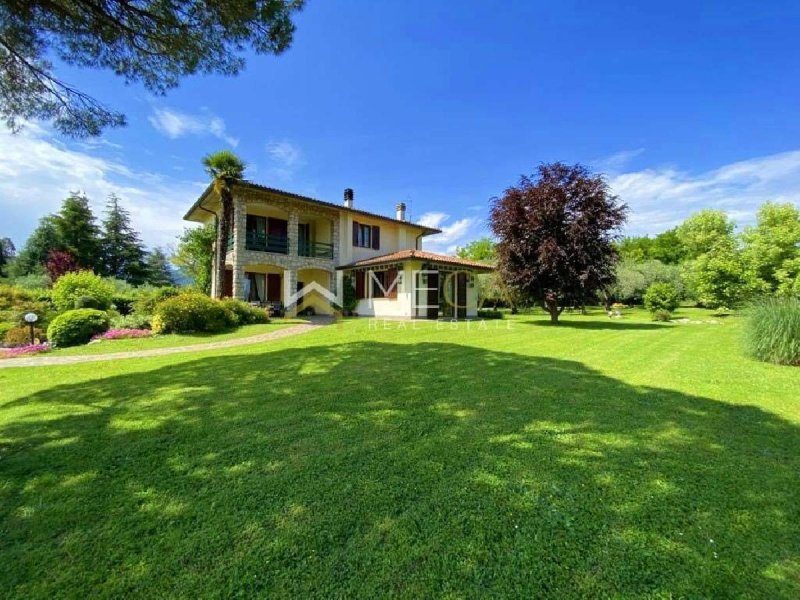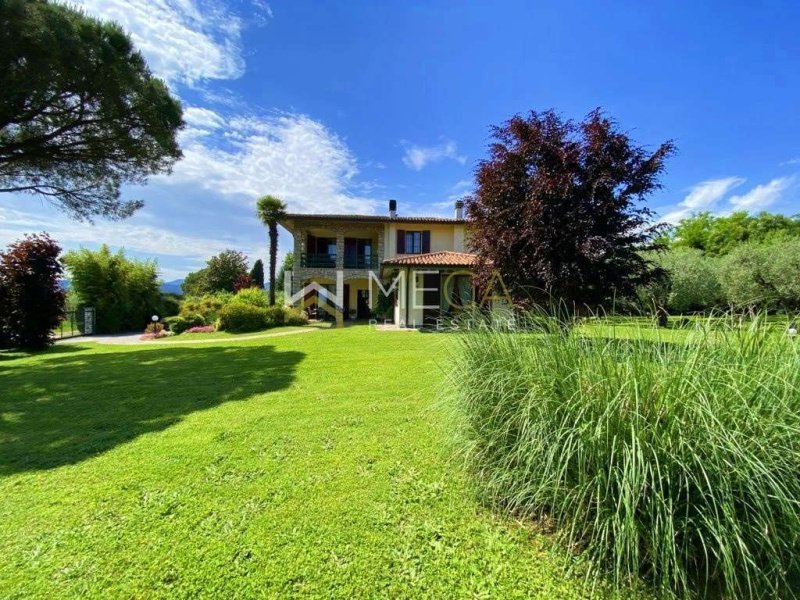San Felice del Benaco, Portese, in a very quiet area surrounded by greenery, beautiful manor house surrounded by an enchanting private garden of 2,200 sqm, planted with the most varied types of plants of different colors and on which there is also an olive grove composed of 33 olive trees.
The villa was renovated and expanded in 2002, the constantly sunny position and the openings with windows larger than the standard allow exceptional brightness in the internal rooms, which are also very spacious.
The layout of the rooms, the finishes and the colors of the house make the interiors very harmonious, elegant and welcoming.
On the ground floor we find the living area consisting of the living room and the dining room measuring approximately 60 square meters of floor space, access onto two porches of 15 and 27 square meters respectively, the semi-habitable kitchen, a study, also with access to the porch and a bathroom;
The living zone is embellished with a beautiful stube and a precious marble fireplace with ventilation.
On the first floor there is the sleeping area consisting of three bedrooms of which: one double and one single both with access to a spacious 27 sqm terrace, further single bedroom also with access to another 15 sqm terrace, bathroom.
A beautiful stube has also been installed in the sleeping area.
Basement with garage, laundry, storage room, cellar.
Condensing boiler with ceiling heating ducting, air conditioning, solar panels, approval already obtained for photovoltaic system installation, canalized ventilation, zoned perimeter alarm connected to the police and controlled by home authomation system.
Energy class D.
Distance from the lake: 1 km;
Distance from the center and the Church: 850 m;
Distance from the nursery school: 800 m;
Distance from primary school, middle school, post office, bank, supermarket and all services: 2.4 km
Monuments and places of interest:
Parish Church: Built between 1740 and 1781 by Antonio Corbellini, in Baroque style and dedicated to SS. Felice, Adauto and Flavia. Of particular importance is the Romanino altarpiece from the 16th century, the Martyrdom of St. Bartholomew by Johann Carl Loth in the right nave, the frescoes on the vault by Carlo Innocenzo Carloni and Giosuè Scotti from 1760 and the Nativity by Zenone Veronese in the sacristy. Sanctuary of Carmine: Church of Carmine 15th century, dedicated to the Madonna del Carmine. The imposing building is characteristic of the last stage of Lombard Gothic architecture in its simplest form: the "rustic" one, strongly linked to the Romanesque tradition. The main door has a pointed arch, with a central rose window and two lateral single-lancet windows. It was restored from 1954 to '59 for the architectural part and from 1963 onwards for the pictorial part. Santa Maria del Carmine was begun in 1460 on the area of a small chapel with the support of Ludovico II Gonzaga and his son Cardinal Francesco. It was consecrated in 1482, even though it was already to the Madonna del Carmine. The imposing building is characteristic of the last stage of Lombard Gothic architecture in its simplest form: the "rustic" one, strongly linked to the Romanesque tradition. The main door was functioning in 1452. Today it is a destination for numerous pilgrims from all over the world. On the fourth weekend of July, the statue of the Madonna del Carmelo is carried, on Saturday, in solemn procession from the Sanctuary of the Madonna del Carmine, to the Parish Church of San Felice del Benaco; the next day, Sunday, the procession resumes with the return of the Madonna to the Sanctuary, through the streets of the town decorated with flowers and festive garlands. Palazzo Rotingo: Located on via XX Settembre, at number 11, it is now the seat of the town hall of San Felice del Benaco.
自动翻译所用的语言
San Felice del Benaco, località Portese, in zona molto tranquilla e immersa nel verde, stupenda villa padronale circondata da un incantevole giardino privato di 2.200 mq, piantumato con le più varie tipologie di piante di diversi colori e sul quale è presente anche uliveto composto da 33 piante d'ulivo.
La villa è stata ristrutturata ed ampliata nel 2002, la posizione costantemente soleggiata e le aperture con finestre di dimensioni maggiori rispetto allo standard permettono una luminosità eccezionale degli ambienti interni, i quali sono a loro volta molto spaziosi.
La disposizione delle stanze, le finiture ed i colori della casa rendono gli interni molto armoniosi, eleganti ed accoglienti.
Al piano terra troviamo la zona living composta dal soggiorno e la sala da pranzo ampie circa 60 mq calpestabili, accesso su due portici rispettivamente di 15 e 27 mq, la cucina semiabitabile, uno studio, anch'esso con accesso a porticato ed un bagno;
Il soggiorno è impreziosito da una bellissima stube e da un pregiato camino in marmo con ventilazione.
Al piano primo si trova la zona notte composta da tre camere di cui : una matrimoniale ed una singola entrambe con accesso ad una spaziosa terrazza di 27 mq, ulteriore camera singola anch'essa con accesso ad altra terrazza di 15 mq, bagno.
Anche nella zona notte è stata installata una bellissima stube.
Piano interrato con garage, lavanderia, ripostiglio, cantina.
Caldaia a condensazione con canalizzazione del riscaldamento a soffitto, aria condizionata, pannelli solari, approvazione per installazione impianto fotovoltaico, ventilazione canalizzata, allarme perimetrale a zone collegato con la polizia e comandato da impianto di domotica.
Classe energetica D.
Distanza dal lago : 1 km;
Distanza dal centro e dalla Chiesa : 850 mt;
Distanza dalla scuola materna : 800 mt;
Distanza da scuola elementare, scuola media, poste, banca, supermercato e tutti i servizi : 2.4 km
Monumenti e luoghi d'interesse:
Chiesa Parrocchiale : Edificata tra il 1740 e il 1781 ad opera di Antonio Corbellini, in stile barocco e dedicata ai SS. Felice, Adauto e Flavia. Di particolare importanza è la Pala del Romanino del sec.XVI, nella navata destra Martirio di S. Bartolomeo di Johann Carl Loth, gli affreschi della volta di Carlo Innocenzo Carloni e a Giosuè Scotti del 1760 e la Natività di Zenone Veronese nella sagrestia. Santuario del Carmine : Chiesa del Carmine secolo XV, dedicata alla Madonna del Carmine. L'imponente edificio è caratteristico dell'ultimo stadio dell'architettura gotico lombarda nella sua forma più semplice: quella “rustica”, fortemente legata alla tradizione romanica. La porta principale è a sesto acuto, con rosone centrale e due monofore laterali. È stato restaurato dal 1954 al '59 per la parte architettonica e dal 1963 in poi per quella pittorica. Santa Maria del Carmine venne iniziata nel 1460 sull'area di una piccola cappella con l'appoggio di Ludovico II Gonzaga e di suo figlio il cardinale Francesco. Venne consacrata nel 1482, anche se era gi àlla madonna del Carmine. L'imponente edificio è caratteristico dell'ultimo stadio dell'architettura gotico lombarda nella sua forma più semplice: quella “rustica”, fortemente legata alla tradizione romanica. La porta principale è a ses funzionante nel 1452. Oggi è meta di numerosi pellegrini da tutto il mondo. Il quarto fine settimana di luglio, la statua della Madonna del Carmelo viene portata, il sabato, in processione solenne dal Santuario della Madonna del Carmine, alla Chiesa Parrocchiale di San Felice del Benaco; il giorno dopo, la domenica, la processione riprende con il rientro della Madonna al Santuario, per le vie del paese addobbato di fiori e ghirlande a festa. Palazzo Rotingo : Situato il via XX Settembre, al numero civico 11, è ora la sede del municipio di San Felice del Benaco.
CLASSE ENERGETICA: D 178,13 kWh/m2 a
San Felice del Benaco, Portese, in einer sehr ruhigen Gegend, umgeben von viel Grün, wunderschönes Herrenhaus, umgeben von einem bezaubernden privaten Garten von 2.200 qm, bepflanzt mit den verschiedensten Pflanzenarten in verschiedenen Farben und auf dem sich auch ein Olivenhain befindet von 33 Olivenbäumen.
Die Villa wurde 2002 renoviert und erweitert, die ständig sonnige Lage und die Öffnungen mit größeren Fenstern als der Standard ermöglichen eine außergewöhnliche Helligkeit in den Innenräumen, die ebenfalls sehr geräumig sind.
Die Raumaufteilung, die Oberflächen und die Farben des Hauses machen die Innenräume sehr harmonisch, elegant und einladend.
Im Erdgeschoss finden wir den Wohnbereich bestehend aus Wohnzimmer und Esszimmer mit einer Wohnfläche von ca. 60 Quadratmetern, Zugang zu zwei Veranden von 15 bzw. 27 Quadratmetern, die halb bewohnbare Küche, ein Arbeitszimmer, ebenfalls mit Zugang zur Veranda und einem Badezimmer;
Der Wohnbereich ist mit einer wunderschönen Stube und einem wertvollen Marmorkamin mit Belüftung ausgestattet.
Im ersten Stock befindet sich der Schlafbereich, bestehend aus drei Schlafzimmern, davon: ein Doppel- und ein Einzelzimmer, beide mit Zugang zu einer geräumigen 27 qm großen Terrasse, ein weiteres Einzelzimmer ebenfalls mit Zugang zu einer weiteren 15 qm großen Terrasse, Badezimmer.
Im Schlafbereich wurde auch eine schöne Stube eingerichtet.
Untergeschoss mit Garage, Wasche, Abstellraum, Keller.
Brennwertkessel mit Deckenheizungskanälen, Klimaanlage, Sonnenkollektoren, Genehmigung für die Installation einer Photovoltaikanlage bereits vorhanden, kanalisiert Belüftung, in Zonen eingeteilter Perimeteralarm, der mit der Polizei verbunden ist und über ein Hausautomationssystem gesteuert wird.
Entfernung vom See: 1 km;
Entfernung vom Zentrum und der Kirche: 850 m;
Entfernung vom Kindergarten: 800 m;
Entfernung zur Grundschule, Mittelschule, Post, Bank, Supermarkt und allen Dienstleistungen: 2,4 km
Denkmäler und Sehenswürdigkeiten:
Pfarrkirche: Zwischen 1740 und 1781 von Antonio Corbellini im Barockstil erbaut und den Heiligen Felice, Adauto und Flavia gewidmet. Von besonderer Bedeutung sind das Romanino-Altarbild aus dem 16. Jahrhundert, das Martyrium des Heiligen Bartholomäus von Johann Carl Loth im rechten Kirchenschiff, die Fresken am Gewölbe von Carlo Innocenzo Carloni und Giosuè Scotti aus dem Jahr 1760 und die Geburt Christi von Zenone Veronese in der Sakristei. Heiligtum von Carmine: Kirche von Carmine aus dem 15. Jahrhundert, der Madonna del Carmine gewidmet. Das imposante Gebäude ist charakteristisch für die letzte Phase der lombardischen Gotik in ihrer einfachsten Form: die „rustikale“, die stark mit der romanischen Tradition verbunden ist. Das Hauptportal hat einen Spitzbogen mit einem zentralen Rosettenfenster und zwei seitlichen einbogigen Fenstern. Es wurde von 1954 bis 1959 im architektonischen Teil und ab 1963 im malerischen Teil restauriert. Der Bau von Santa Maria del Carmine wurde 1460 auf dem Gelände einer kleinen Kapelle mit Unterstützung von Ludovico II. Gonzaga und seinem Sohn Kardinal Francesco begonnen. Es wurde 1482 geweiht, obwohl es bereits der Madonna del Carmine gewidmet war. Das imposante Gebäude ist charakteristisch für die letzte Phase der lombardischen Gotik in ihrer einfachsten Form: die „rustikale“, die stark mit der romanischen Tradition verbunden ist. Das Hauptportal war 1452 in Betrieb. Heute ist es ein Ziel für zahlreiche Pilger aus aller Welt. Am vierten Wochenende im Juli wird die Statue der Madonna del Carmelo am Samstag in einer feierlichen Prozession vom Heiligtum der Madonna del Carmine zur Pfarrkirche San Felice del Benaco getragen; am nächsten Tag, dem Sonntag, wird die Prozession mit der Rückkehr der Madonna zum Heiligtum fortgesetzt, durch die mit Blumen und festlichen Girlanden geschmückten Straßen der Stadt. Palazzo Rotingo: Er befindet sich in der Via XX Settembre, Nummer 11, und ist heute Sitz des Rathauses von San Felice del Benaco.


